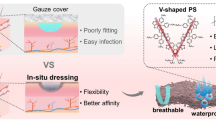Abstract
By combining solvent evaporation with wet phase inversion technique, an asymmetric polyurethane membrane (ASPU) was constructed from a sulfanilamide-conjugated PU, as a potential candidate for wound dressing application. As a result of the combined membrane-formation method, the ASPU membrane was constituted by an integral and dense skin layer supported by a porous sublayer. The skin layer was found impermeable to pathogenic organisms, while the sublayer was intended for draining excessive exudates. Compared with typical PU membrane dressings commercially available, the ASPU membrane exhibited a reasonable moisture vapor transmission rate, as well as significantly improved gas circulation and exudate absorption capabilities, which synergistically optimized the wound microenvironment for proper healing. Furthermore, the sulfanilamide-conjugated PU constituting ASPU membrane was designed as susceptible to urease, a representative hydrolase derived from inflammation-causing pathogens. In the presence of urease, urea linkages adjacent to sulfanilamide monomeric units were found catalytically cleaved, enabling release of free antibiotic sulfanilamide that held pharmacological activity from ASPU membrane. When incubated without urease, those cleavage sites exhibited substantially high resistance against hydrolysis so that no sulfanilamide release was detected throughout the incubation period. In this inflammation-responsive manner, the anti-inflammatory efficiency of antibiotics was significantly enhanced, while undesirable side effects associated with antibiotic abuse was minimized. Cell culture assay further revealed that the ASPU membrane displayed no cytotoxicity toward normal human dermis fibroblasts, suggesting a biocompatible potential. Based on these results, the multifunctional ASPU membrane designed in this study might be clinically suitable as an ideal biomedical dressing for wound care.












Similar content being viewed by others
References
Menaker GM (2002) Semin Cutan Med Surg 21:171
Ovington LG (2007) Clin Dermatol 25:33
Boateng JS, Matthews KH, Stevens HNE, Eccleston GM (2008) J Pharm Sci 97:2892
Wang LS, Chow PY, Tan DCW, Zhang WD, Yang YY (2004) Adv Mater 16:1790
Bertal K, Shepherd J, Douglas CWI, Madsen J, Morse A, Edmondson S, Armes SP, Lewis A, MacNeil S (2009) J Mater Sci 44:6233. doi:10.1007/s10853-009-3843-7
Smith TJ, Kennedy JE, Higginbotham CL (2010) J Mater Sci 45:2884. doi:10.1007/s10853-010-4278-x
Salgado CL, Sanchez EMS, Mano JF, Moraes AM (2012) J Mater Sci 47:659. doi:10.1007/s10853-011-5836-6
Zahedi P, Rezaeian I, Jafari SH (2013) J Mater Sci 48:3147. doi:10.1007/s10853-012-7092-9
Yang JM, Lin HT (2004) J Membr Sci 243:1
Yang JM, Yang SJ, Lin HT, Chen JK (2007) J Biomed Mater Res B 80B:43
Morton LM, Phillips TJ (2012) Semin Cutan Med Surg 31:33
Mi FL, Shyu SS, Wu YB, Lee ST, Shyong JY, Huang RN (2001) Biomaterials 22:165
Longo DL, Fauci AS, Kasper DL, Hauser SL, Jameson JL, Loscalzo J (2011) Harrison’s principles of internal medicine, 18th edn. McGraw Hill Professional, New York
Arias CA, Murray BE (2009) N Engl J Med 360:439
Xu H, Ning H, Chen Y, Fan H, Shi B (2013) Prog Org Coat 76:924
Queen D, Gaylor JDS, Evans JH, Courtney JM, Reid WH (1987) Biomaterials 8:367
Kimbal JW (1975) Biology, 3rd edn. Addison-Wesley Publishing Company, Boston
Lamke LO, Nilsson GE, Reithner HL (1977) Burns 3:159
Wu P (1993) Experimental and theoretical study of water vapour transmission in hydrocolloid wound dressings, 3rd edn. PhD thesis. Strathclyde University, Glasgow
Sharma PD (2007) Microbiology, 2nd edn. Rastogi Publications, Meerut
Smith PT, King AD Jr, Goodman N (1993) J Gen Microbiol 139:957
Agnihotri N, Gupta V, Joshi RM (2004) Burn 30:241
Fang SD, Xia ZP (2000) Clinical infection in surgery, 1st edn. Shenyang Press, Shenyang
Borgquist O, Gustafsson L, Ingemansson R, Malmsjö M (2009) Wounds 21:302
Hess CT (2005) Wound care, 5th edn. Lippincott Williams & Wilkins, Ambler
Dhandayuthapani B, Yoshida Y, Maekawa T, Kumar DS (2011) Int J Polym Sci 2011:1
Hess CT (2013) Clinical guide to skin & wound care, 7th edn. Lippincott Williams & Wilkins, Ambler
Winter GD (1962) Nature 193:293
Khil MS, Cha DI, Kim HY, Kim IS, Bhattarai N (2003) J Biomed Mater Res B 67B:675
Wong P (1980) Physical evaluation of hydrogel as a burn wound dressing. MSc thesis, Strathclyde University, Glasgow
Yoo HJ, Kim HD (2008) J Appl Polym Sci 107:331
Stannett VT (1968) In: Crank J, Park GS (eds) Diffusion in polymers. Academic Press, New York, p 41
Koros WJ, Hellums MW (1990) In: Kroschwitz JI (ed) Encyclopedia of polymer science and technology. Wiley, New York, p 1211
Yoo HJ, Kim HD (2008) J Biomed Mater Res B 85B:326
Hopfenberg HB (1976) In: Paul DR, Harris FW (eds) Controlled release polymeric formulations. American Chemical Society, Washington, p 26
Woo GLY, Mittelman MW, Santerre JP (2000) Biomaterials 21:1235
Ravina E, Kubinyi H (2011) The evolution of drug discovery: from traditional medicines to modern drugs, 1st edn. Wiley, Weinheim
Acknowledgements
The authors wish to acknowledge financial support from National Natural Science Foundation of China (21206096), New Teachers’ Fund for Doctor Stations, Ministry of Education of China (20120181120116), and Fundamental Research Funds for the Central Universities, China.
Author information
Authors and Affiliations
Corresponding authors
Rights and permissions
About this article
Cite this article
Xu, H., Chang, J., Chen, Y. et al. Asymmetric polyurethane membrane with inflammation-responsive antibacterial activity for potential wound dressing application. J Mater Sci 48, 6625–6639 (2013). https://doi.org/10.1007/s10853-013-7461-z
Received:
Accepted:
Published:
Issue Date:
DOI: https://doi.org/10.1007/s10853-013-7461-z




